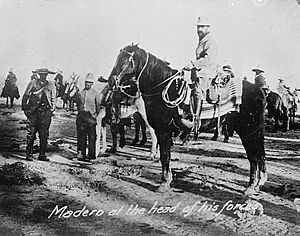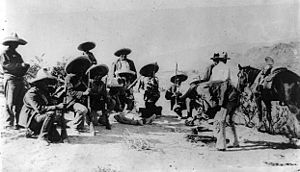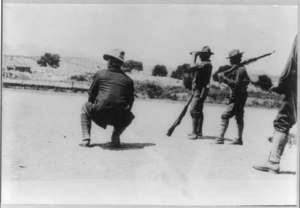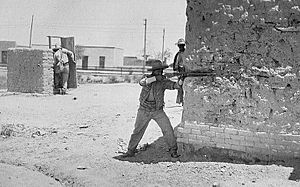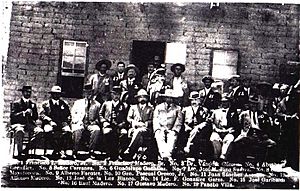Battle of Ciudad Juárez (1911) facts for kids
Quick facts for kids First Battle of Ciudad Juárez |
|||||||
|---|---|---|---|---|---|---|---|
| Part of the Mexican Revolution, Border War | |||||||
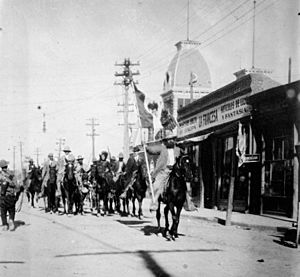 Revolutionaries entering Ciudad Juárez. |
|||||||
|
|||||||
| Belligerents | |||||||
|
|
|
||||||
| Commanders and leaders | |||||||
| Strength | |||||||
| 2,500 | 700 | ||||||
The First Battle of Ciudad Juárez was a major fight during the Mexican Revolution. It happened in April and May 1911. The battle was between the government's army, loyal to President Porfirio Díaz, and rebel forces led by Francisco I. Madero.
Madero's army, with important leaders like Pascual Orozco and Pancho Villa, surrounded Ciudad Juárez in Chihuahua. After two days of intense fighting, the city's defenders gave up. Orozco and Villa took control of the town. This victory, along with Emiliano Zapata's capture of Cuautla in Morelos, showed President Díaz that he couldn't beat the rebels. Because of this, he agreed to a peace deal called the Treaty of Ciudad Juárez. Díaz then resigned and left Mexico, which marked the end of the first part of the Mexican Revolution.
Contents
Why Did the Battle Happen?
Díaz's Long Rule and Growing Unrest
President Porfirio Díaz had ruled Mexico for 34 years. Many people were unhappy with his strict government. This unhappiness eventually led to a big movement led by Francisco Madero.
Madero had been in prison but escaped. From the United States, in November 1910, he called for people to rise up against Díaz. In the northern state of Chihuahua, two important figures answered his call. These were Pascual Orozco, a trader and miner, and Pancho Villa, a well-known rebel leader. They both started fighting Díaz's soldiers using guerrilla tactics.
Rebels Unite and Plan an Attack
Encouraged by Villa and Orozco's actions, and by the Zapatista rebellion in southern Mexico, Madero returned to Mexico in February 1911. After some smaller fights with Díaz's army, Madero, Orozco, and Villa decided to attack Ciudad Juárez.
Taking this city was very important. It would give the rebels control over trade between Mexico and the United States. A big win like this could also be the final push needed to end Díaz's rule.
This attack was also special because it was the first time the rebel army would fight a regular battle. Before, they mostly used surprise attacks and guerrilla warfare. Now, Madero, Villa, and Orozco had enough men to fight like a professional army. However, the government's soldiers were still better trained.
Government's Missed Chance
The government had a chance to stop the rebels. They could have sent troops from the state capital, Ciudad Chihuahua, to trap Madero. But the governor of Chihuahua, Miguel Ahumada, was worried. He feared that if soldiers left the capital, there would be more unrest. Also, many of the government's soldiers had been forced to join. They actually supported the rebels. So, the troops in Ciudad Chihuahua decided to stay put.
The Battle of Ciudad Juárez Begins
Early Fights and Rebel Morale
Madero first sent some of his forces to attack Agua Prieta as a distraction. This attack was successful. It was also important because the rebels used railroads to surprise the enemy for the first time. American forces even got involved in the fighting. Federal troops took Agua Prieta back two weeks later.
The main attack on Ciudad Juárez began on April 7. Madero led 1,500 men, with Villa and Orozco each leading 500 men ahead of him. On their way, the rebels captured the towns of Temosachi and Bauche. This greatly boosted their spirits.
Surrounding the City
Ciudad Juárez was defended by 700 government troops. The rebels surrounded the city on three sides. The only way out for the defenders was north, towards El Paso in the United States. The rebels cut off the city's water supply, and the defenders were running low on ammunition. Still, the city's commander, General Juan N. Navarro, refused to give up. He believed the rebels were too new to sieges to capture the city.
Rebel Generals Disobey Orders
At this point, President Díaz tried to make a deal with Madero. This was especially after the Zapatistas captured Cuautla. Díaz planned to offer some things to Madero, who was more moderate. Once Madero was satisfied, Díaz wanted to crush the more radical rebels. A ceasefire was agreed upon on April 23.
Madero was ready to negotiate and stop fighting. But Villa and Orozco did not agree. On May 8, these two generals launched an attack on the city without asking Madero. They claimed it was a "spontaneous" fight. The excuse for the attack was that a government officer insulted a female rebel. Madero tried to stop the fighting, but Orozco and Villa kept going. They even avoided Madero so they wouldn't have to directly disobey him. When Madero finally spoke to Orozco, he was told the battle was already too far along to stop.
General Navarro, pressured by Madero, tried to keep the ceasefire. This hurt his defenders. The rebels captured the outer parts of the city without any resistance. No government officer would break the order to hold fire. Instead, the troops moved deeper into the city.
Orozco attacked from the north, and Villa from the south. They led their troops close to the U.S. border. This way, shots from either side were less likely to cross into America. Thousands of American civilians gathered in El Paso to watch the battle.
Clever Attack Strategies
The rebels quickly took control of the bridges connecting the city to the U.S. They cut off electricity and telegraph lines. They captured the bullring and reached the edge of the city center on the first day. General Navarro had prepared strong defenses with trenches and barricades.
However, the rebels had a secret weapon: lots of dynamite. They also had experts from other wars, like Boer General Ben Viljoen and Giuseppe Garibaldi II, the grandson of a famous Italian revolutionary. To get past the strong defenses, the rebels used a clever plan. Instead of fighting in the streets, they used dynamite to blow holes in the walls of adobe houses. This allowed them to move through the city house by house, avoiding the government's machine guns and barricades.
Another new tactic the rebels used was rotating their troops. American journalist Timothy Turner, watching from El Paso, wrote about this. Instead of everyone attacking at once, Villa and Orozco had their soldiers fight for a few hours. Then, they would go back to safe spots to rest and sleep. Other rebels would take their place. This meant the rebel troops were always fresh, while the smaller number of government defenders were tired and always on alert.
The city's defenders ran out of water on May 8. They were trapped in just a few buildings in the city center. Most of the fighting was now very close. This meant the government's advantage in machine guns and artillery no longer mattered. Some reports say General Navarro's troops were close to rebelling against him. To prevent this, Navarro started talking with the rebels. He surrendered the town two days later, on May 10, 1911.
What Happened Next?
After capturing Ciudad Juárez, Madero and his revolutionary movement gained a lot of respect. People in Mexico and the U.S. saw them as a serious force. American journalists even crossed the border to congratulate Madero. They reported how quickly and well order was brought back to the city.
Díaz's Fall from Power
The victory at Ciudad Juárez changed how people saw the rebels. Before this battle, many thought the rebels would scatter when faced with real soldiers. But the fall of Juárez proved them wrong. It showed how strong the rebel forces truly were.
This success quickly convinced President Porfirio Díaz to agree to resign. Two days after the battle, Díaz signed the Treaty of Ciudad Juárez with Madero. Ten days after the battle, he resigned and went to live in France. This ended the first part of the Mexican Revolution. It also showed that even well-defended cities could fall to rebel armies.
Disagreements Among the Winners
The battle also led to problems between Madero and his generals, Villa and Orozco. Tensions started during the battle and continued afterward. Besides disobeying Madero during the fight, they also argued about paying their soldiers. They also disagreed with Madero's choice of Venustiano Carranza as his defense minister. Carranza was a civilian who joined the revolution late, which Orozco disliked.
The biggest argument was about what to do with General Juan N. Navarro, who defended Ciudad Juárez. Both Villa and Orozco wanted him executed. They said he had killed rebel prisoners earlier. Madero disagreed. He wanted to show his authority as a civilian leader over the military generals. Madero personally took Navarro across the U.S. border to El Paso to keep him safe. Madero did give gold from the local bank to the troops, as the generals wanted.
Later Events After the Battle
Pascual Orozco was not happy with the political jobs he was offered in Madero's government. He became even angrier when Madero asked him to fight Zapata. So, in March 1912, less than a year after the battle, Orozco openly rebelled against Madero. He later supported Victoriano Huerta when Huerta took power from Madero. After Huerta's government fell, Orozco went to the U.S. He was later killed by Texas Rangers while trying to return to Mexico to start another revolt.
Pancho Villa stayed loyal to Madero and even fought against Orozco. He played a big part in Huerta's fall. However, Villa later disagreed with Carranza and lost the fight for control of the revolution to Carranza's general, Álvaro Obregón.
Images for kids
See also
 In Spanish: Toma de Ciudad Juárez para niños
In Spanish: Toma de Ciudad Juárez para niños


